 Monday, July 13, 2009 at 09:39PM | by
Monday, July 13, 2009 at 09:39PM | by  BVD | in
BVD | in  Sunset Paintings,
Sunset Paintings,  Sunsetology | tagged
Sunsetology | tagged  Albemarle County,
Albemarle County,  Blue Ridge,
Blue Ridge,  Stony Point | | Comments Off
Stony Point | | Comments Off  Monday, July 13, 2009 at 09:39PM | by
Monday, July 13, 2009 at 09:39PM | by  BVD | in
BVD | in  Sunset Paintings,
Sunset Paintings,  Sunsetology | tagged
Sunsetology | tagged  Albemarle County,
Albemarle County,  Blue Ridge,
Blue Ridge,  Stony Point |
Stony Point |  Share Article | Comments Off
Share Article | Comments Off 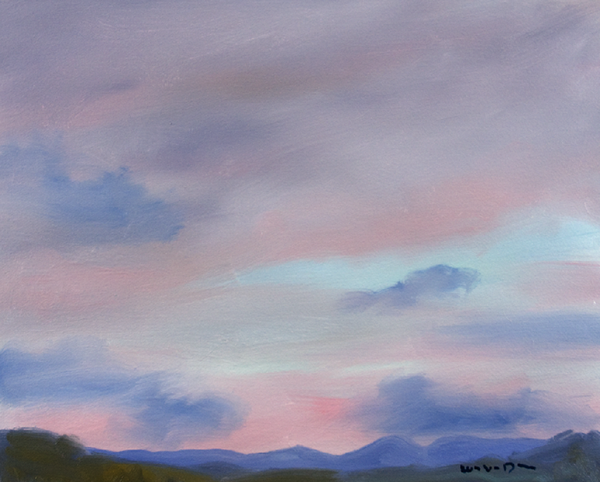 Stony Point, Albemarle County, Va. Oil on paper, 16 x 20.
Stony Point, Albemarle County, Va. Oil on paper, 16 x 20.
The best thing about yesterday’s visit to Frederick, after the lunch, was going to the Delaplaine Center for the Arts. What a place! Along with the beautiful Carroll Creek “linear park” and the trompe-l’oeil Community Bridge mural project, the Delaplaine makes you wonder how a town of 60,000 can possibly do so much.
The Delaplaine was featuring its regional juried exhibit (closing on the 19th) and an exhibition, ‘Urban Landscapes’, by Stephen Hay. We only had time for the large regional exhibit, but I sensed, on the way out, that I had missed something by not going through the Hay show as well, and a visit to his site confirmed that for me.
In the juried show, I was struck by many things, including the works of Robert Stuart Cohen, who does mesmerizing semi-abstractions using repeated brocade-like patterns. His painting ‘The Yellow Box’ made a big impression on me, partly because the title added a third dimension to what might otherwise have been perceived as a (phenomenally complex) two-dimensional design – the ‘yellow box’ became for me like a marble sarcophagus or holy object, an ark.
But all four of us ultimately were glued to the works of Michael Douglas Jones of Damascus, Maryland – and I’m glad I have links I can give you, because they’re difficult to describe. Even when you first see them and think they’re collages of found objects – albeit rare ones from past centuries – they’re remarkable. As you keep looking and realize that Jones has created these objects or made them what they are – they become nothing short of amazing.
For me, the significance of the Delaplaine – this was my second or third visit – is the sense that it gives me of the Frederick art community as open and expansive. It somehow avoids the insularity or cliquishness you find in other places. Further, it’s not elitist, yet it avoids elitism without pandering or compromise.
Another town of this size, this close to major cities (Frederick is in some ways a satellite of both Washington and Baltimore), could become drained of identity. A town in Virginia with a similar name, last time I checked had long suffered that fate (in relation to Washington). Residents sometimes call that place ‘Dead Fred.’ I can’t imagine people saying the same about the Fred in Maryland.
 Sunday, July 12, 2009 at 09:48PM | by
Sunday, July 12, 2009 at 09:48PM | by  BVD | in
BVD | in  Sunset Paintings | tagged
Sunset Paintings | tagged  Albemarle County,
Albemarle County,  Blue Ridge,
Blue Ridge,  Carroll Creek,
Carroll Creek,  Damascus Maryland,
Damascus Maryland,  Delaplaine Center for the Arts,
Delaplaine Center for the Arts,  Frederick,
Frederick,  Fredericksburg,
Fredericksburg,  Michael Douglas Jones,
Michael Douglas Jones,  Robert Stuart Cohen,
Robert Stuart Cohen,  Stephen Hay,
Stephen Hay,  Stony Point |
Stony Point |  Share Article | Comments Off
Share Article | Comments Off I’ve spent most of the day going to Frederick, Maryland, and back for a birthday lunch (although my birthday’s still a few days off) at Volt. More about that later. Also later – by sometime tomorrow afternoon – I’ll have the posting of tonight’s sunset, as sketched from Fredericksburg Road in Greene County, Virginia, on the way home.
The July skies and weather, especially in the evenings, have been rather shifty and low-key, but tonight’s colors were more like pinks and blues reflected on the inside of a shell; whether the painting comes up to that ... well, we can imagine it does, until tomorrow! And I will have notes from the day.
 BVD
BVD
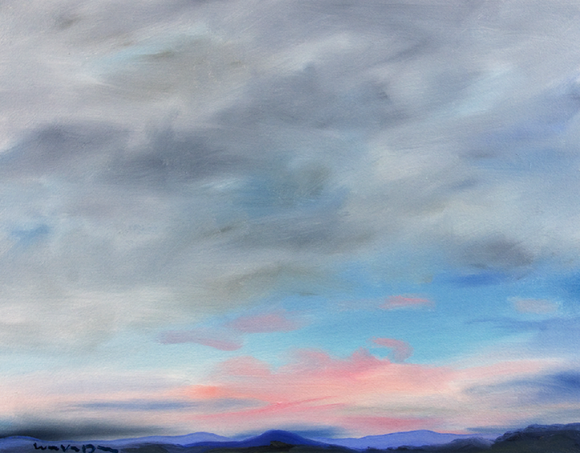 Fredericksburg Road & U.S. 29, Greene County, Va. Oil on paper, 16 x 20.
Fredericksburg Road & U.S. 29, Greene County, Va. Oil on paper, 16 x 20.
Well, so far, we’ve got the sunset. My ‘notes from the day’ have mushroomed a bit, and are still in process – I will either add them here or to the next sunset. Meanwhile, I did post part of yesterday’s story, here.
* * * *
For a long while on the drive home, the sun was always about to drop off a shelf of high dark gray, and in remaining at the margin turned a sheet of higher white cloud beyond the gray opalescent – this as we passed through Opal, Virginia. Not a big coincidence or a sign of cosmic consciousness, given how many times I drive through Opal and how much of the time the clouds look opalescent.
Finally behind the white screen the sun bloomed with soft dandelion blaze, and at the edges of the circle, nearly imperceptible, a prismatic effect like a sun dog that isn’t quite there yet, a strangely dark gold glow.
By the time we got to Greene County, these observations turned out to have nothing to do with the sunset ...
 Saturday, July 11, 2009 at 09:12PM | by
Saturday, July 11, 2009 at 09:12PM | by  BVD | in
BVD | in  Sunset Paintings | tagged
Sunset Paintings | tagged  Blue Ridge,
Blue Ridge,  Frederick,
Frederick,  Greene County,
Greene County,  Maryland,
Maryland,  Opal Virginia,
Opal Virginia,  Virginia,
Virginia,  Volt |
Volt |  Share Article | Comments Off
Share Article | Comments Off 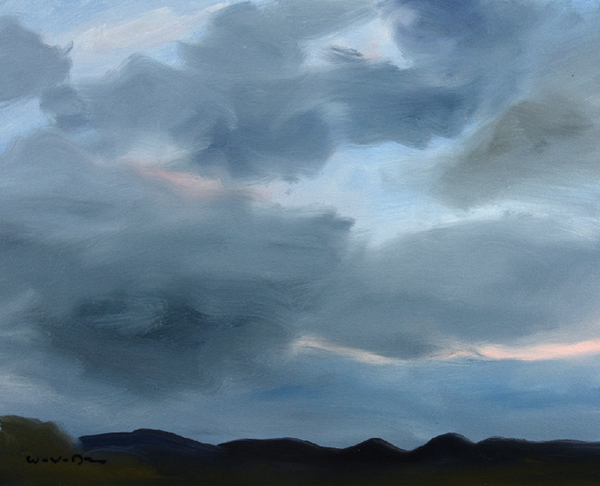 Stony Point, Albemarle County, Va. Oil on paper, 16 x 20.
Stony Point, Albemarle County, Va. Oil on paper, 16 x 20.
Out with Flint today (new visitors: Flint’s a pound-found foxhound, runs 10–15 or more miles while I walk about seven, cross-country) – I didn’t realize what a rare summer day it was until I had to come down off the embankment above the Rivanna to encourage him to go in and get a drink.
There’d been a gunshot in the distance somewhere across the way. He’d just gotten in the water, heard the shot, sort of stood there looking in its direction for a moment, then scrambled up the 20 feet or so to where I was standing. (He’s a gun-, thunder- and, probably safe to assume, whip-shy foxhound, which may be why he came to be at the pound.)
I decided that, after running in the heat, he’d better get some water, and, hoping there wouldn’t be any more shots, I found my way down to one of the sand bars on the river. Flint, feeling a little safer with me (as seen previously here), followed – and started walking around in the water, lapping it up as he went.
The view from river level was a revelation – partly because it’s so familiar. I’m so used to everything being kind of hazy at this time of year – the woods up and down the river arching from the banks and bluffs toward the water, the many sand bars and mud flats and the stranded trees stuck in various places by floods, but all of this more or less bonded by a subtle metallic veil of humidity. In typical light, even the river itself fails to separate, the view upstream or down, foreshortened at a low angle, opaque reflection – light bouncing into other light bounced everywhere by atmosphere.
It’s an effect I’ve loved since I was a kid and that I would deliberately exaggerate, blurring my eyes to make everything even more unified.
(“Please don’t throw me in that briar patch!”)
As much as I can revel in the murk, I was stunned by the Rivanna in the clear light of such a blue summer day. The shallow river was crystal clear, showing sand and silt-rock-leaf bottom like a brownish topaz. Every variation on the bottom, every bubble and wrinkle in the current showed itself. Trees all along the banks stood out in infinitely varied green relief and distinct perspective, not the usual moody mass. So vivid and fresh, the clarity of what I was seeing became part of the touch of the air, and the sensation of breathing.
Curiously, the sharp distinctions took nothing away from the ‘oneness’; if anything, they made it almost too much.
Watching the beautiful white dog walk in the water and drink it at the same time didn’t hurt, either.
The coolest moment came about an hour later when we made our second pass by the river – turned out Flint was somewhere in back of me on a ramble, or a chase, but I came to the edge of the embankment just in case I might find him down there. No dog, but through the foliage on the surface of the water the shadow of a large bird moving swiftly up the middle of the river. I looked up, wondering if I’d be able to make out what was casting the shadow. Through the leaves above my head, maybe 30 feet above the river’s surface, I caught a long look at a great blue heron flying through the light.
 Wednesday, July 8, 2009 at 09:22PM | by
Wednesday, July 8, 2009 at 09:22PM | by  BVD | in
BVD | in  Sunset Paintings | tagged
Sunset Paintings | tagged  Albemarle County,
Albemarle County,  Blue Ridge,
Blue Ridge,  Rivanna River,
Rivanna River,  Stony Point |
Stony Point |  Share Article | Comments Off
Share Article | Comments Off 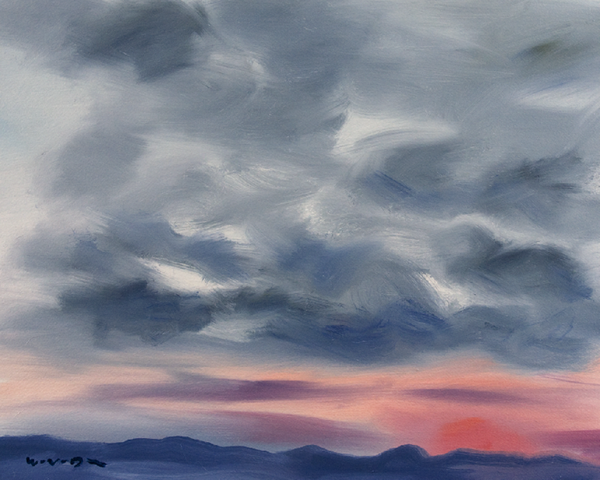 Stony Point, Albemarle County, Va. Oil on canvas, 16 x 20.
Stony Point, Albemarle County, Va. Oil on canvas, 16 x 20.
On an alien planet with a double sunset, one of the suns fell orange on a purple-magenta horizon and soon another showed up, blazing rose against the orange sky left over from the first. A bit confusing for a painter from Earth. The atmosphere seemed quite breathable, the vegetation familiar. I recognized everybody in the house. Just don’t know how we got here.
 Tuesday, July 7, 2009 at 09:23PM | by
Tuesday, July 7, 2009 at 09:23PM | by  BVD | in
BVD | in  Sunset Paintings | tagged
Sunset Paintings | tagged  Albemarle County,
Albemarle County,  Blue Ridge,
Blue Ridge,  Stony Point |
Stony Point |  Share Article | Comments Off
Share Article | Comments Off 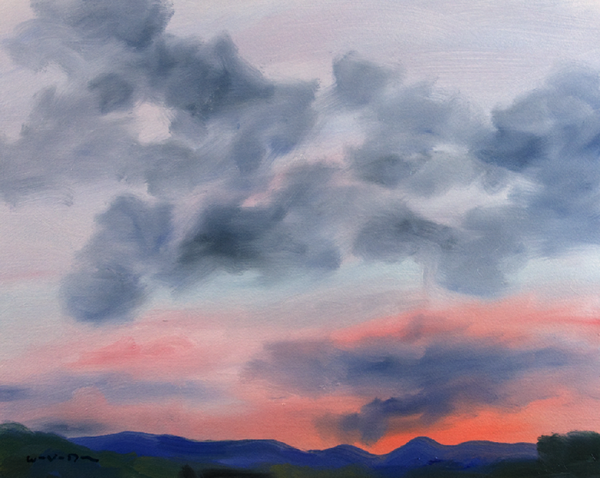 Stony Point, Albemarle County, Va. Oil on paper, 16 x 20.
Stony Point, Albemarle County, Va. Oil on paper, 16 x 20.
“What a difference a day makes.”
This line, which came to me of course because of the change from yesterday, made me think of my dad, because he used to sing the song all the time. More precisely, he’d always sing the first two lines –
What a difference a day makes
Twenty-four little hours
– and that’s all. This of course left me in some doubt as to whether the difference a day made was good or bad. Little did I know that the difference:
Brought the sun and the flowers
Where there used to be rain.
I might attribute this truncation to some sadness in Dad’s life, of which there was plenty, except many songs went on beyond their initial lines to spell out a sad tale, and he didn’t go on with those, either. For example, of “Blues in the Night” (Harold Arlen and Johnny Mercer), what I always heard was:
My mama done told me
When I was in knee pants
My mama done told me, ‘Son ... ’
Really, it was 40 years before I found out what it was his mama done told him.
All I ever knew of W.C. Handy’s “St. Louis Blues” was:
I hate to see that evening sun go down.
And he sang that line literally hundreds of times, just out of nowhere. I think I even remember my mother singing that line, and she hardly sang at all.
(The most wonderful song along these thematic lines – my #1 diurnal tune – is “Rising Sun” by Sonny Terry and Brownie McGhee.)
The difference a day makes is one facet of painting these sunsets – but I’m thinking that the difference it doesn’t make is at least an equally large and the more subtle part of the matter. What I notice when I see all the days arrayed is both change and the constant – something in time that doesn’t change.
This thought in turn makes me wish I could have paid more attention to both math and physics – and specifically to mathematical constants – evidently numbers that arise naturally, such as pi, the ratio of a circle’s circumference to its diameter (well, yes, I know you knew this, but I’d totally forgotten) – and to physical constants, like gravitation or the speed of light.
I never thought any of that was very interesting, or relevant to what I was interested in. Now I think there’s a Constant embedded in the succession of days.
 Monday, July 6, 2009 at 09:24PM | by
Monday, July 6, 2009 at 09:24PM | by  BVD | in
BVD | in  A Painting A Day,
A Painting A Day,  Sunset Paintings,
Sunset Paintings,  Sunsetology | tagged
Sunsetology | tagged  Albemarle County,
Albemarle County,  Blue Ridge,
Blue Ridge,  Harold Arlen,
Harold Arlen,  Johnny Mercer,
Johnny Mercer,  Stony Point,
Stony Point,  Theodore Van Doren,
Theodore Van Doren,  W.C. Handy,
W.C. Handy,  pi,
pi,  “Blues in the Night”,
“Blues in the Night”,  “St. Louis Blues”,
“St. Louis Blues”,  “What a Difference a Day Makes” |
“What a Difference a Day Makes” |  Share Article | Comments Off
Share Article | Comments Off